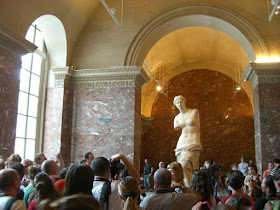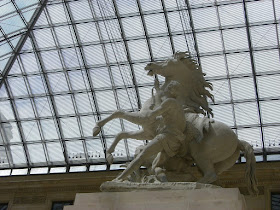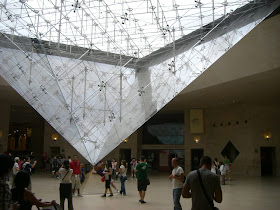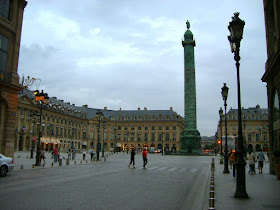After enjoying fantastic views of Paris from La Tour Eiffel, Le Sacré Coeur and Le Arch de Triomphe, our third day in Paris would begin with a visit to Les Tuilleries and Le Louvre. I also was eager to walk along the rues of La Ile de la Cité and to enjoy a close view of Nôtre Dame and a night view of La Place Vendome.
Day 3
Star sights of this day in Paris:
- Les Tuilleries
- Le Grand Louvre
- Centre Pompidou
- Île de la Cité and Nôtre Dame
- Sainte Chapelle and La Palais de Justice
- Conciergerie
- Hôtel de Ville (City Hall)
- Rue de Rivoli
- Palais Royal
- Place Vendome at night
Les Tuilleries
From Les Tuilleries, there is a interesting view of L'Obélisque of La Place de la Concorde and L'Arc de Triomphe. All these people went to Le Louvre
 In the background, L'Arc du Carroussel and Le Louvre. The day was a bit cloudy in Paris, so it was a good day to visit Le Louvre
In the background, L'Arc du Carroussel and Le Louvre. The day was a bit cloudy in Paris, so it was a good day to visit Le Louvre Through L'Arc du Carroussel appears La Pyramide du Louvre, the main entrance to the museum
Through L'Arc du Carroussel appears La Pyramide du Louvre, the main entrance to the museumLe Grand Louvre
 Searching for a good photo of La Pyramide du Louvre
Searching for a good photo of La Pyramide du Louvre When I saw the Louvre from this point for the first time I became pretty impressed: it's really beautiful and its façades have an special charm
When I saw the Louvre from this point for the first time I became pretty impressed: it's really beautiful and its façades have an special charm
The Arc de Triomphe du Carrousel was built between 1806 and 1808 by Napoleon following the model of the Arc of Constantine in Rome
 An overall view of la Cour Napoleon with the pyramid in the middle
An overall view of la Cour Napoleon with the pyramid in the middle
An imposing view of La Pyramide du Louvre in La Cour Napoléon
 The Denon wing, where La Mona Lisa waits for her fans inside Le Louvre
The Denon wing, where La Mona Lisa waits for her fans inside Le Louvre Under the Pyramid there is the main entrance to
Le Louvre, always crowded and impregnate with sunlight
Under the Pyramid there is the main entrance to
Le Louvre, always crowded and impregnate with sunlight I really liked this sensual sculpture of Antonio Canova
I really liked this sensual sculpture of Antonio Canova La Venus de Milo, one of the most amazing treasures inside Le Louvre
La Venus de Milo, one of the most amazing treasures inside Le Louvre The Winged Victory of Samothrace. The Victory — “Nike” in Greek — is shown as if she were just alighting on the prow of the ship to which she is bringing divine favor
The Winged Victory of Samothrace. The Victory — “Nike” in Greek — is shown as if she were just alighting on the prow of the ship to which she is bringing divine favor
The surroundings of La Mona Lisa are always really crowded
 Eventually I managed to get closer this wonderful painting
Eventually I managed to get closer this wonderful painting On the left is the painting The Raft of the Medusa. This painting explains how in 1816, the frigate “Medusa” sank because of the incompetence of a captain who had obtained his post through political relations. Due to a shortage of lifeboats, 149 people piled onto a raft that drifted for twelve days. Only fifteen survived the ensuing slaughter, madness, and cannibalism
On the left is the painting The Raft of the Medusa. This painting explains how in 1816, the frigate “Medusa” sank because of the incompetence of a captain who had obtained his post through political relations. Due to a shortage of lifeboats, 149 people piled onto a raft that drifted for twelve days. Only fifteen survived the ensuing slaughter, madness, and cannibalism July 28. Liberty Leading the People: In July 1830, three days of riots known as “Les Trois Glorieuses” led to the downfall of Charles X and the enthronement of Louis-Philip, despite a vain attempt by the people of Paris to re-establish the Republic on 28 July, the day celebrated here. The belltowers of Notre-Dame situate the scene behind the huge barricade, already piled with corpses. Striding over the top, Phrygian bonnet on her head and rifle in hand, the allegorical figure of the Republic waves the tricolor flag and urges the people to follow her
July 28. Liberty Leading the People: In July 1830, three days of riots known as “Les Trois Glorieuses” led to the downfall of Charles X and the enthronement of Louis-Philip, despite a vain attempt by the people of Paris to re-establish the Republic on 28 July, the day celebrated here. The belltowers of Notre-Dame situate the scene behind the huge barricade, already piled with corpses. Striding over the top, Phrygian bonnet on her head and rifle in hand, the allegorical figure of the Republic waves the tricolor flag and urges the people to follow her Here you can see one of the two large marble sculptures representing horses restrained by grooms which were commissioned in 1739 for the horse pond in the gardens of the Château de Marly. In 1743, the king chose the models exhibited in the Louvre courtyard; the marble sculptures were installed at Marly in 1745. In 1749, they were moved to Paris on the initiative of the painter David, and placed on high pedestals at the bottom of the Champs-Elysées
Here you can see one of the two large marble sculptures representing horses restrained by grooms which were commissioned in 1739 for the horse pond in the gardens of the Château de Marly. In 1743, the king chose the models exhibited in the Louvre courtyard; the marble sculptures were installed at Marly in 1745. In 1749, they were moved to Paris on the initiative of the painter David, and placed on high pedestals at the bottom of the Champs-Elysées The Code of Hammurabi (Codex Hammurabi) is a well-preserved ancient law code, created ca. 1790 BC (middle chronology) in ancient Babylon. It was enacted by the sixth Babylonian king, Hammurabi
The Code of Hammurabi (Codex Hammurabi) is a well-preserved ancient law code, created ca. 1790 BC (middle chronology) in ancient Babylon. It was enacted by the sixth Babylonian king, Hammurabi
La Pyramide Inversée (The Inverted Pyramid) is a skylight constructed in an underground shopping mall in front of the Louvre Museum in Paris. It may be thought of as a smaller sibling of the more famous Louvre Pyramid proper, yet turned upside down: its upturned base is easily overlooked from outside
Centre Pompidou

The Centre Pompidou is an original building where all of the functional structural elements of the building were colour-coded: green pipes are plumbing, blue ducts are for climate control, electrical wires are encased in yellow, and circulation elements and devices for safety are red
 Here you can see better some of the colour-coded functional structural elements of the Centre Pompidou in Paris
Here you can see better some of the colour-coded functional structural elements of the Centre Pompidou in Paris Inside Le Centre Pompidou there is a Cinema, a huge Library, restaurants and, of course, the Musée National d'Art Moderne which is the largest museum for modern art in Europe
Inside Le Centre Pompidou there is a Cinema, a huge Library, restaurants and, of course, the Musée National d'Art Moderne which is the largest museum for modern art in Europe
Probably, one of the most colourful fountains in Paris is Stravinsky Fountain
Île de la Cité and Nôtre Dame
 After having lunch near Le Centre Pompidou, we went to La Ile de la Cité, the more ancient area of Paris. And one of the most beautiful buildings in this island is, obviously, Nôtre Dame
After having lunch near Le Centre Pompidou, we went to La Ile de la Cité, the more ancient area of Paris. And one of the most beautiful buildings in this island is, obviously, Nôtre DameSainte Chapelle and Le Palais de Justice

The only building which can be considered as beautiful as Notre Dame is La Sainte Chapelle. This gothic chapelle is considered as the most beautiful gothic building and is located inside the enclosure of Le Palais de Justice. Le Palais de Justice is the only building of La Ile de la Cité which still keeps its original function
Hôtel de Ville

L'Hôtel de Ville de Paris (City hall) is a really decorated building, so it seems a monument instead of a city hall. Its location is privileged. Near The Seine and the islands of La Ile de la Cité and La Ile de Sant Louis
Conciergerie
 The Paris beach is a curious use of a little part of the right bank of The Seine. Here everyone can enjoy the sunlight and get tanned with a great view of La Ile de la Cité
The Paris beach is a curious use of a little part of the right bank of The Seine. Here everyone can enjoy the sunlight and get tanned with a great view of La Ile de la CitéSurroundings of Le Louvre
 Claude Perrault’s Colonnade is the easternmost façade of the Palais du Louvre in Paris. It has been celebrated as the foremost masterpiece of French Architectural Classicism since its construction, mostly between 1667 and 1670. For centuries, Perrault’s Colonnade has provided a model for many grand edifices in Europe and America like, for instance, the Metropolitan Museum in New York City
Claude Perrault’s Colonnade is the easternmost façade of the Palais du Louvre in Paris. It has been celebrated as the foremost masterpiece of French Architectural Classicism since its construction, mostly between 1667 and 1670. For centuries, Perrault’s Colonnade has provided a model for many grand edifices in Europe and America like, for instance, the Metropolitan Museum in New York City Located at the center of Paris, by the Seine and in front of the Perrault’s Colonnade, this former parish of the kings of France is generally regarded as the Church of the Louvre. Founded in the 7th century, it was rebuilt many times over several centuries, revealing several mixtures of style, Roman, Gothic, Renaissance. The most striking exterior feature is the porch, with a rose window, and a balustrade above which encircles the whole church
Located at the center of Paris, by the Seine and in front of the Perrault’s Colonnade, this former parish of the kings of France is generally regarded as the Church of the Louvre. Founded in the 7th century, it was rebuilt many times over several centuries, revealing several mixtures of style, Roman, Gothic, Renaissance. The most striking exterior feature is the porch, with a rose window, and a balustrade above which encircles the whole church
Rue de Rivoli is one of the most glamorous streets in Paris. In this picture, on the left was Le Louvre and, on the right, was Le Palais Royal
Palais Royal

One of the most wonderful features of Paris is that it has a lot of fabulous Palaces really integrated with the other more usual buildings. An example of this feature is Le Palais Royal, separated from Le Louvre by la Rue de Rivoli and with a majestic garden at the rear of the Palace
This image of the rear garden of Le Palais Royal shows how beautiful it is. An extraordinary environment to walk
Place Vendôme
When I saw this square, I became fascinated. La Place Vendôme was originally built to house the embassies of foreign countries. Now, with the imposing Napoleon column in the center, it's one of the more glamorous places in Paris with the Ritz Hotel and the most famous jewellery shops
The symmetry of La Place Vendôme makes this square really beautiful and it has such an elegant style that it captivated me
Here can be seen the Ritz Hotel with its entrance
You can see more pictures of the days I spent in Paris clicking on the links below:
- First day in Paris (Les Champs Elysées)
- Second day in Paris (La Tour Eiffel and Montmartre)
- Third day in Paris (Le Grand Louvre and Île de la Cité)
- Fourth day in Paris (Les Invalides and Musée d'Orsay)
- Fifth day in Paris (Le Panthéon and Nôtre Dame)
- Sixth day in Paris (Jardin du Luxembourg and La Villette)
- Seventh day in Paris (Versailles)
- Eighth day in Paris (La Défense)
Besides, in France I have visited the following beautiful places I strongly recommend:
Finally, other great cities I have already visited are:
- Barcelona
- Berlin
- New York and Washington
- London
- Dublin in Irleland
- Istanbul in Turkey
- Saint Petersburg
- Rome and The Vatican
- Florence in Tuscany
- Lisboa in Portugal
- Madrid
- Venezia
- Dubrovnik in Croatia
- Tortuguero, Caribe, Arenal, Monteverde and San José in Costa Rica
- Marrakech in Morocco











No hay comentarios:
Publicar un comentario